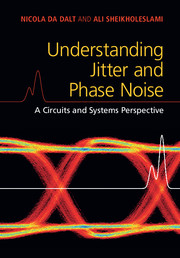Book contents
- Frontmatter
- Dedication
- Contents
- Preface
- Acknowledgments
- 1 Introduction to Jitter
- 2 Basics of Jitter
- 3 Jitter and Phase Noise
- 4 Jitter and Phase Noise in Circuits
- 5 Effects of Jitter in Synchronous Digital Circuits
- 6 Effects of Jitter on Data Converters
- 7 Effects of Jitter in Wireline Applications
- 8 Phase Noise in Wireless Applications
- 9 Advanced Concepts on Jitter and Phase Noise
- 10 Numerical Methods
- Appendix A Review of Random Variables and Processes
- Appendix B Matlab Code for Jitter Generation and Analysis
- Bibliography
- Index
1 - Introduction to Jitter
Published online by Cambridge University Press: 19 February 2018
- Frontmatter
- Dedication
- Contents
- Preface
- Acknowledgments
- 1 Introduction to Jitter
- 2 Basics of Jitter
- 3 Jitter and Phase Noise
- 4 Jitter and Phase Noise in Circuits
- 5 Effects of Jitter in Synchronous Digital Circuits
- 6 Effects of Jitter on Data Converters
- 7 Effects of Jitter in Wireline Applications
- 8 Phase Noise in Wireless Applications
- 9 Advanced Concepts on Jitter and Phase Noise
- 10 Numerical Methods
- Appendix A Review of Random Variables and Processes
- Appendix B Matlab Code for Jitter Generation and Analysis
- Bibliography
- Index
Summary
Imagine a lunar eclipse is to occur later tonight at around 1:57 am when you are fast asleep. You decide to set your camera to capture the event, but being uncertain of the actual time, you would set the camera to start a few minutes before the nominal time and run it for a few minutes after 1:57 am. In this process, you have included a margin around the nominal time so as to minimize the risk of not capturing the event on your camera.
Imagine you have an important meeting at 8:00 am sharp, but you are uncertain about your watch being a bit too fast or too slow. Determined not to be late, you decide to arrive by 7:55 am according to your watch, just in case your watch is a bit slow. This is indeed a practical way to deal with uncertainty in time.
Imagine you have a ticket for the bullet train in Tokyo that leaves the train station at 1:12 pm sharp. You are at the station and on the right platform, and you take the train that leaves the station at 1:12 pm sharp. But a few minutes later, you notice that your watch is two minutes fast compared to the time being displayed on the train, and you realize that you are on the 1:10 pm train and you are moving towards a different destination.
Missing an event, being late or early, and getting on the wrong train are all consequences of timing uncertainties in our daily lives. In digital circuits, we deal with very similar situations when we try to time events by a clock that has its own timing uncertainty, called jitter, and in doing so we may miss an event, such as not capturing critical data, or cause bit errors, e.g., capturing the wrong data. Our goal, however, is to prevent such errors from occurring, or to minimize their probabilities. We do this first by carefully studying the nature of these uncertainties and modeling their characteristics.
This chapter provides a few concrete examples from electronic circuits and systems where timing uncertainties have a profound impact on the accuracy of their operation. Our goal here is to qualitatively introduce the concept of jitter and intuitively explain how it should be characterized and dealt with.
- Type
- Chapter
- Information
- Understanding Jitter and Phase NoiseA Circuits and Systems Perspective, pp. 1 - 14Publisher: Cambridge University PressPrint publication year: 2018



